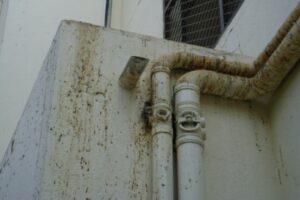House Sparrow:
General Description

- The house sparrow is small and has a stocky appearance.
- The upper parts are reddish brown streaked with black, and the under parts are gray.
- The female and immature birds lack any distinctive markings.
- The male has a characteristic black throat, gray crown, and chestnut-colored nape.
Life Cycle and Common Characteristics
1. Reproduction:
- The female lays 3-9 eggs speckled with dense black-brown spots.
- The incubation takes place for 14 days.
- It takes care of feeding the chicks for 11 to 17 days.
- The young are fledged (ready for flight) at about 14 days.
- House sparrows can produce up to 5 broods per year.
- The high reproductive rate is offset by an annual natural mortality rate ranging between 40 and 60%, often depending on the severity of the winter.
2. Habits and behaviors:
- House sparrows can inhabit virtually every part of a city, nesting and/or perching in and around all types of residential and commercial buildings.
- Flocks of house sparrows can be serious nuisances.
- In rural areas, they are destructive around poultry and other livestock operations as they consume and contaminate large amounts of livestock feed.
- They are also capable of destroying building insulation.
- Large flocks often develop around food-serving establishments, shopping malls, warehouses, stadiums, and airport hangers.
- In residential areas, sparrows are pests in gardens and around yards, where they frequently displace desirable songbirds.
- The nests of house sparrows are usually built in, on, or near buildings.
- The nests are typically messy and are comprised of twigs, grass, and paper.
- Sparrows will also nest in trees and shrubs, usually using the same nesting locations and tree cavities year after year.
- Sparrow nests constructed on and around power lines and in electrical sub-stations have caused serious fire hazards.
- Sparrows are gregarious (i.e., group-loving).
3. Feeding:
- The food of the house sparrow varies, but grain is its preferred item. They also feed on the fruits and buds of some trees and bushes, as well as green leaves.
- The average adult sparrow eats less than 1/4 oz. of food daily.
- During the breeding season, the nestlings are fed insects.
- In rural areas, sparrows thrive at cattle feedlots, dairy farms, and hog and poultry farms where food and shelter are plentiful.
- In urban locations, they depend upon human trash that provides foods such as bread, fat, and other table scraps.
Economic & Health Damage of Birds
- Economic Damage

- Some types of birds may cause economic or health damage to homes and their occupants, which puts them in the ranks of dangerous household pests. When birds, such as sparrows and pigeons, gather in large numbers on the roofs, windows, and trellises of houses and electricity poles, take positions or places of shelter, breed, and then set out to feed and return with the materials they may carry, they work on the dirt and pollution of the house.

- The excrement of these birds and the remains of their food cause stains on the walls and walls with sticky dirt, and some fungi grow on them, which in turn secrete acidic substances that cause corrosion of buildings.

- Damage may occur as a result of nests and dead birds gathering in air-conditioning vents or rainwater drainage. It also spoils light bulbs and causes damage to electrical connections.
- Losses are inflicted on home gardens as a result of their feeding and destruction of fruits, vegetables, and small seedlings, in addition to the disturbance they cause when they are present in large numbers, especially in the early morning and at sunset.

- The containment of bird droppings on ammonia and folic acid leads to the corrosion of car paint and the corrosion of metals and devices.
- Some birds and their flocks cause problems and danger to air navigation lines and airports, and collisions of some birds in the air may result in accidents, even if they are rare.
- Health Damage:
Birds can harbor disease organisms that may affect people, pets, and domesticated animals. However, reports of disease outbreaks directly linked to urban pest birds are rare, and the actual incidence of transmission of diseases from urban pest birds is difficult to assess. Diseases and ectoparasites transmitted by birds to humans are mentioned below.
|
Causing Agent and Injury |
Disease |
|
Avian influenza
|
|
Histoplasmosis
|
|
Cryptococcosis
|
|
Ornithosis
|
|
Pigeon Fancier’s disease
|




